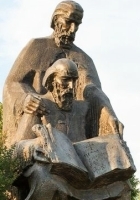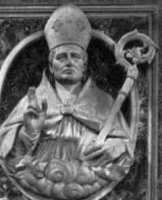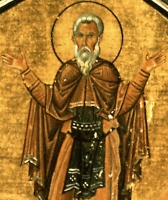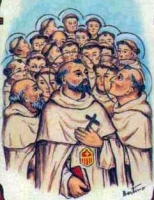| 14 February |
• yesterday • tomorrow |
| Optional Memorial of Saint Valentine, Bishop, Martyr |

• Apostle of Bulgaria
• Apostle of the Slavs
• Apostle of the Southern Slavs
• Constantin
• Constantine the Philospher
• Constantine
• Cyril the Philosopher
• Equal of the Apostles
• Slavorum Apostoli
• 27 July as one of the Apostles of Bulgaria
• 6 April (Velehrd, Moravia)
Brother of Saint Methodius. Born to the Greek nobility; his family was connected with the senate of Thessalonica, and his mother Maria may have been Slavic. Studied at the University of Constantinople, and taught philosophy there. Deacon. Priest. Librarian at the church of Santa Sophia. Monk, taking the name Cyril. Sent with Methodius by the emperor in 861 to convert the Jewish Khazars of Russia, a mission that was successful, and which allowed him to learn the Khazar's language. In 863, sent with Methodius to convert Moravians in their native tongue. Though some western clergy opposed their efforts and refused to ordain their candidates for the priesthood, they did good work. Developed an alphabet for the Slavonic language that eventually became what is known today as the Cyrillic. After initial criticism for their use of it, the brothers achieved approval of the Liturgy in the Slavonic language. May have been bishop, but may have died before the consecration ceremony.
827 at Thessalonica, Greece as Constantin
14 February 869 at Rome, Italy of natural causes
• against storms
• ecumenism
• Slavic peoples (given in 1863 by Pope Pius IX
• unity of the Eastern and Western Churches
• Bohemia
• Bosnia
• Bosnia-Herzegovina
• Bulgaria
• Carinthia, Austria
• Carniola
• Circassia
• Croatia
• Czech Republic
• Czechoslovakia
• Dacia
• Dalmatia
• Europe (given in 1980 by Pope John Paul II)
• Khazaria
• Krain
• Krajna
• Kranjska
• Moravia
• Pannonia
• Russia
• Silesia
• Slovenia
• Yugoslavia
• Ljubljana, Slovenia, archdiocese of
• Maribor, Slovenia, archdiocese of
• Saints Cyril and Methodius of Toronto, Ontario, diocese of
• Brno, Czechia, city of
• with Saint Methodius
• Oriental monk holding a church with the help of Methodius
• surrounded by Bulgarian converts
• wearing a long philosopher's coat
When the time came for Cyril to set out from this world to the peace of his heavenly homeland, he prayed to God with his hands outstretched and his eyes filled with tears: "O Lord, my God, you have created the choirs of angels and spiritual powers; you have stretched forth the heavens and established the earth, creating all that exists from nothing. You hear those who obey your will and keep your commands in holy fear. Hear my prayer and protect your faithful people, for you have established me as their unsuitable and unworthy servant. "Make your people known for the unit and profession of their faith. Inspire the hearts of your people with your word and your teaching. You called us to preach the Gospel of your Christ and to encourage them to lives and works pleasing to you. "I now return to you, your people, your gift to me. Direct them with your powerful right hand, and protect them under the shadow of your wings. May all praise and glorify your name, the Father, Son, and Holy Spirit. Amen. - from an old Slavonic biography of Saint Cyril
https://catholicsaints.info/saint-cyril/

• Apostle of Bulgaria
• Apostle of the Slavs
• Apostle of the Southern Slavs
• Equal of the Apostles
• Slavorum Apostoli
• 27 July as one of the Apostles of Bulgaria
• 6 April (Velehrd, Moravia)
Brother of Saint Cyril. Born to the Greek nobility. Studied at the University of Constantinople, and taught philosophy there. Priest. Sent with Cyril by the emperor in 861 to convert the Jewish Khazars of Russia, a mission that was successful, and which allowed him to learn the Khazar's language. In 863, he was sent with Cyril to convert Moravians in their native tongue. Though some western clergy opposed their efforts and refused to ordain their candidates for the priesthood, they did good work. Helped develop an alphabet for the Slavonic language that eventually became what is known as the Cyrillic today. After initial criticism for their use of it, they achieved approval of the Liturgy in the Slavonic language. Bishop. Evangelized in Moravia, Bohemia, Pannonia, and Poland. Baptized Saint Ludmilla and Duke Boriwoi. Archbishop of Velehred (in the modern Czech Republic), but deposed and imprisoned in 870 due to the opposition of German clergy with his work. Often in trouble over his use of Slavonic in liturgy, some claiming he preached heresy; repeatedly cleared of charges. Translated the Bible into the Slavonic languages. Pioneered the use of local and vernacular languages in liturgical settings.
826 at Thessalonica, Greece
6 April 885 at Moravia (modern Czech Republic)
• against storms
• ecumenism
• Slavic peoples (given in 1863 by Pope Pius IX
• unity of the Eastern and Western Churches
• Bohemia
• Bosnia
• Bosnia-Herzegovina
• Bulgaria
• Carinthia, Austria
• Carniola
• Circassia
• Croatia
• Czech Republic
• Czechoslovakia
• Dacia
• Dalmatia
• Europe (given in 1980 by Pope John Paul II
• Khazaria
• Krain
• Krajna
• Kranjska
• Moravia
• Pannonia
• Russia
• Silesia
• Slovenia
• Yugoslavia
• Ljubljana, Slovenia, archdiocese of
• Maribor, Slovenia, archdiocese of
• Saints Cyril and Methodius of Toronto, Ontario, diocese of
• Brno, Czechia, city of
• with Saint Cyril
• Oriental bishop holding up a church with Saint Cyril
• Oriental bishop holding a picture of the Last Judgement
https://catholicsaints.info/saint-methodius/

Priest in Rome, possibly a bishop. Physician. Imprisoned for giving aid to martyrs in prison, and while there converted the jailer by restoring sight to the jailer's daughter. While Valentine of Terni and Valentine of Rome sometimes have separate entries in martyrologies and biographies, most scholars believe they are the same person.
There are several theories about the origin of Valentine's Day celebrations that relate to love and sentiment. Some believe the Romans had a mid-February custom where boys drew the names of girls in honour of the sex and fertility goddess, Februata Juno; pastors "baptised" this holiday, like some others, by substituting the names of saints such as Valentine to suppress the practice. Others maintain that the custom of sending Valentines on 14 February stems from the belief that birds begin to pair on that date; by 1477 the English associated lovers with the feast of Valentine because on that day "every bird chooses him a mate." The custom of men and women writing love letters to their Valentine started on this day. Other "romance" traditions have become attached to this feast, including pinning bay leaves to your pillow on Valentine's Eve so that you will see your future mate that night in your dreams.
• beaten and beheaded c.269 at Rome, Italy
• buried on the Flaminian Way outside Rome
• relics later translated to the Church of Saint Praxedes
• affianced, betrothed or engaged couples
• against epilepsy
• against fainting
• against plague
• apiarists, bee keepers
• greeting card manufacturers
• greetings
• happy marriages
• love
• lovers
• travellers
• young people
• Brendo, Italy
• Bussolengo, Italy
• birds
• roses
• bishop with a crippled or epileptic child at his feet
• bishop with a rooster nearby
• bishop performing a wedding
• bishop refusing to adore an idol
• bishop being beheaded
• priest bearing a sword
• priest holding a sun
• priest giving sight to a blind girl
https://catholicsaints.info/saint-valentine-of-rome/>

• Giovanni Battista della Concezione
• Giovanni Garcia Xixon
• John Baptist de la Concepción Garcia
• Juan Bautista Rico
• Juan Bautista de la Concepción
• Juan García Gijón
• Juan García Xixón
• Juan Rico
15 February (diocese of Ciudad Real, Spain and diocese of Córdoba, Spain)
Fifth of eight children born to Xixón and Isabel García Marcos López-Rico; three of his siblings entered religious orders. As a child he was so drawn to follow the example of the saints that he nearly starved himself and endangered his health trying to live an ascetic life. At the age of 15 he met Saint Teresa of Avila which left him with a fascination with the Carmelites. He studied with the Carmelites in Almodóvar, Spain, and then at seminaries in Baeza and Toledo. Juan joined he Trinitarians on 28 June 1580, and made his profession on 29 June 1581. Ordained to the priesthood in 1585. On 20 August 1599 he received approval from Pope Clement VIII to begin a reformation of the Trinitarians; he based his efforts on the example of Saint Teresa of Avila and the original Rule of the Order which required six hours of prayer a day. In addition to reforming existing houses, he founded more monasteries that followed this new, invigorated form. Prolific writer on theology.
10 July 1561 in Almodóvar del Campo, Ciudad Real, Spain
14 February 1613 in Córdoba, Spain of nephritis
25 May 1975 by Pope Paul VI
https://catholicsaints.info/saint-juan-garcia-lopez-rico/

• Modestinus of Mercogliano
• Modestin, Modestino
10 June (re-internment of relics)
Born to the nobility of Asia Minor. Bishop of Antioch, Turkey in 302, working with Saint Fiorentinus and Saint Flavianus. Imprisoned in the persecutions of Diocletian, he was miraculously freed and fled to Italy. There he was imprisoned for his faith in Locri, Italy by the local governor, but was released after he healed the governor‘s daughter through prayer; the governor and his family converted to Christianity. Evangelist in the area of Avellino, Italy, thought to have been led by Michael the Archangel to the places that most needed his preaching; reported to have convered 4,000 in one area. Imprisoned and martyred in persecutions of Maximian.
c.245 in Antioch (modern Turkey)
• burned to death by being wrapped in heated armor on 14 February 311 in Mercogliano, diocese of Avellino, Italy
• relics re-discovered 1166–1167 during a construction project led by Bishop William of Avellino
• relics re-interred in the crypt of the cathedral of Avellino on 10 June 1167
• Pre-Congregation
• at the request of Bishop Francis of Avellino, in 1308 Pope Clement V granted an indulgence to those who made a pilgrimage to their shrine
• Avellino, Italy, city of (given in 1220 by Ruggiero of Avellino)
• Avellino, Italy, diocese of (given in 1220 by Ruggiero of Avellino)
• Mercogliano, Italy
https://catholicsaints.info/saint-modestinus-of-avellino/

• Fiorentinus of Mercogliano
• Fiorentino
10 June (re-internment of relics)
Priest in Antioch, Turkey, led by Saint Modestinus of Avellina. Imprisoned for his faith in the persecutions of Diocletian, he fled to Italy. There he was again imprisoned and martyred in persecutions of Maximian.
• burned to death by being wrapped in heated armor on 15 February 311 in Mercogliano, diocese of Avellino, Italy
• relics re-discovered 1166–1167 during a construction project led by Bishop William of Avellino
• relics re-interred in the crypt of the cathedral of Avellino on 10 June 1167
• Pre-Congregation
• at the request of Bishop Francis of Avellino, in 1308 Pope Clement V granted an indulgence to those who made a pilgrimage to their shrine
• Avellino, Italy, city of (given in 1220 by Ruggiero of Avellino)
• Avellino, Italy, diocese of (given in 1220 by Ruggiero of Avellino)
• Mercogliano, Italy
https://catholicsaints.info/saint-fiorentinus-of-avellino/

• Flavianus of Mercogliano
• Flaviano
10 June (re-internment of relics)
Deacon in Antioch, Turkey, serving Saint Modestinus of Avellina. Imprisoned for his faith in the persecutions of Diocletian, he fled to Italy. There he was again imprisoned and martyred in persecutions of Maximian.
• burned to death by being wrapped in heated armor on 15 February 311 in Mercogliano, diocese of Avellino, Italy
• relics re-discovered 1166–1167 during a construction project led by Bishop William of Avellino
• relics re-interred in the crypt of the cathedral of Avellino on 10 June 1167
• Pre-Congregation
• at the request of Bishop Francis of Avellino, in 1308 Pope Clement V granted an indulgence to those who made a pilgrimage to their shrine
• Avellino, Italy, city of (given in 1220 by Ruggiero of Avellino)
• Avellino, Italy, diocese of (given in 1220 by Ruggiero of Avellino)
• Mercogliano, Italy
https://catholicsaints.info/saint-flavianus-of-avellino/

Nostrian, Nostrien, Nostriano
16 August (discovery of relics; date set in 1619)
Fifteenth bishop of Naples, Italy, in the mid-5th century, serving for 17 years. Fought against the spread of the Arian, Manichean and Pelagian heresies in his diocese. Helped hold his people together and adhering to the faith during a period of barbarian invasion of the aging Roman empire, and helped support the civic life of the city of Naples. Gave refuge to Christians, including Saint Gaudiosus of Abitina and Saint Quodvultdeus of Carthage, who fled Carthage after it fell to the Vandals.
• between 452 and 465 (records vary) of natural causes
• buried in the catacombs of San Gaudioso in Naples, Italy
• relics enshrined in the church of San Gennaro all'Olmo in Naples in the 10th century in a marble urn under the high altar
• relics re-discovered and re-enshrined on 16 August 1612
• relics re-enshrined in the church of Saints Philip and James in Naples in 1865
2 May 1878 by Pope Leo XIII (cultus confirmation)
https://catholicsaints.info/saint-nostrianus-of-naples/

Youngest of eight children. Educated by the Piarists, and studied engineering in Valencia, Spain. Married to Isabel Rodes Reig, the main witness to his life and martyrdom, and who died in 1993. Spread a Christian outlook and morality among his peers, and known for charity to the poor. He worked as an industrial engineer in the family ceramics firm, and held several important municipal posts in which he put the Church's social teaching into practice. Always involved in parish activities and Catholic youth groups. Against the anti-religious sentiment of 1930's Spain, he worked to save persecuted priests and religious. As he was taken away to his martyrdom for supporting his faith, his wife said, "See you tomorrow!", and he answered, "Until tomorrow or in heaven!". Those who've studied his case believe he had a cause for canonization based solely on his life, not just his martyrdom.
28 June 1889 at Manises, Valencia, Spain
shot on 14 February 1937 in Manises, Valencia, Spain
1 October 1995 by Pope John Paul II
https://catholicsaints.info/blessed-vicente-vilar-david/
Derhen, Derchen, Derc'hen, Derrien
Seventh century knight from the British Isles. Pilgrim to the Holy Lands. Several churches in Brittany, France are named in his honour as he is considered one of the British who brought Christianity to the region.
Legend says that on his return from the Holy Lands, travelling with Néventer of Brittany, the two knights rescued Riok, the two-year-old son of the Count Élorn, from a dragon; Derien defeated the monster by making the Sign of the Cross over it, then using his sash as a leash to drag the animal to the English Channel at Pontusval, France where he ordered it to drown itself. Élorn refused to convert to Christianity, but offered them lands as a reward; they asked for just enough land to build a church.
As dragon slaying usually refers to killing off pagan practices or demonic worship, this legend may refer to Derien healing the nobleman’s child – there is a tradition in the area of asking for his intercession for sick children, and of a well, formerly dedicated to a pagan god but now dedicated to Derien, whose waters could be used to heal children.
British Isles
https://catholicsaints.info/saint-derien-of-brittany/

Ordained by Saint Felician of Foligno. Consecrated bishop of Terni, Italy by Pope Victor I, c.197. Noted evangelist, miracle worker and healer, he was much loved by his flock. Imprisoned, tortured, and beheaded by order of the prefect Placid Furius during the persecution of Aurelius. He was murdered in secret and at night to avoid riots and revenge by the people of Terni. Some scholars believe that he and Saint Valentine of Rome are the same person.
c.175 at Terni, Italy
• on the Via Flaminia between Rome and Terni, Italy
• exhumed and re-interred outside the walls of Terni by his spiritual students
• Altivole, Italy
• Luint, Ovaro, Italy
• Terni, Italy
• Terni-Narni-Amelia, Italy, diocese of
https://catholicsaints.info/saint-valentine-of-terni/
Fortunata of Rome
2nd Sunday of September (patronal feast for the town of Baucina, Italy)
Young woman who converted to Christianity in her teens. Imprisoned for her faith by Imperial Roman troops, she was tortured and eventually executed when she refused to renounce Christianity. Martyr.
c.182 in Palestrina, Rome, Italy
• October 200 in Rome, Italy
• buried in the Saint Ciriaca catacombs of Rome
• relics transferred to Baucina, Italy on 29 January 1750; they arrived on 14 February 1750, and were enshrined in the church of the Collegio di Maria
• relics re-enshrined in an urn in 1840
Baucina, Italy (declared on 9 April 1870 due to the level of devotion by local Christians)
https://catholicsaints.info/saint-fortunata-of-baucina/

Career soldier and equestrian guard of Emperor Theodosius the Younger, he was known to preach to his fellow guards. He eventually left the service to become a hermit on Mount Oxia near Constantinople. Accused and cleared of Eutychianistic heresy. Archimandrite in Bithynia. Active in the Council of Chalcedon. Hermit on Mount Sinope (Skopas) near Chalcedon. Many were attracted to his austerity, holiness, counsel, and teaching; a community of nuns formed at Trichinarion near his mountain.
at Syria
14 February 473 at Mount Skopas of natural causes
https://catholicsaints.info/saint-auxentius-of-bithynia/
Abraames of Harran
Syrian hermit. Hoping to bring the faith to a village at Mount Lebanon, he set up shop as a fruit seller; the people were willing to buy his fruit, but abused him when he started to preach. He converted them by borrowing money to pay their taxes, which kept them out of prison, finally convincing them of the goodness of Christians. He worked to pay the debt, taught them for three years, found a priest to minister to them, then returned to solitude. Chosen bishop of Harran in Mesopotamia. Greatly influenced Theodosius the Younger, who carried that influence to the throne when he became emperor.
c.422 of apparent natural causes at Constantinople while visiting the emperor
https://catholicsaints.info/saint-abraham-of-harran/

• Antoninus of Campagna
• Antoninus Cacciottolo
• Antoninus the Abbot
• Antonino...
Benedictine monk. Forced by war to leave his monastery, he was first a hermit, then abbot at Saint Agrippinus and teacher of the people of Sorrento, Italy.
Campagna, Italy
830 of natural causes
• Campagna, Italy
• Sorrento, Italy
Benedictine monk holding a standard on a city wall
https://catholicsaints.info/saint-antoninus-of-sorrento/
Eleucadio
Convert, brought to the faith by Saint Apollinaris of Ravenna who then ordained him a deacon. Bishop of Ravenna, Italy in 100; legend says he was chosen when a dove rested over his head, which was taken as a sign of the Holy Spirit descending on him.
Greece
• 14 February 112 of natural causes
• relics later enshrined in Pavia, Italy
https://catholicsaints.info/saint-eleuchadius/
To avoid the temptations of the world, around the age of 20 Alexandra walled herself up in a crypt in Alexandria, Egypt and spent 10 years as an anchoress, doing penance, praying, accepting meals through a slot in the wall, and giving spiritual advice to visitors.
latter 4th century in Alexandria, Egypt
late 4th century in Alexandria, Egypt of natural causes
https://catholicsaints.info/saint-alexandra-of-egypt/
Lupance, Lupantius
Seventh century monk at the Abbey of Saint Mesmin near Orleans, France. Feeling a need for solitude with God, he retired to live as a hermit on the banks of the river Vienne near Chinon, France. Reported to have the gift of healing by prayer. A 12th century abbey dedicated to him was built on the site of his hermitage.
https://catholicsaints.info/saint-louans-of-chinon/
Paolino, Pauliano, Paulien
Sixth century bishop of the Le Puy area of Gaul (modern Le Puy-en-Velay, France) based in the city of Ruessium (modern Saint-Paulien).
https://catholicsaints.info/saint-paulian-of-le-puy/
Zenone
Martyr.
• Rome, Italy
• in the cemetery of Praetextatus on the Appian Way outside Rome
https://catholicsaints.info/saint-zeno-of-rome/
Franciscan friar, serving in the Order for 22 years. Travelled and worked with Saint Bernadine of Siena.
1442
https://catholicsaints.info/blessed-vincent-of-siena/
15th century Franciscan tertiary who lived in the Santa Maria Nuova monastery in Ancona, Italy.
Siena, Italy
c.1455 of natural causes
Martyr.
Rome, Italy
https://catholicsaints.info/saint-felicula-of-rome-14-february/
Bishop of Vaison, France.
554
https://catholicsaints.info/saint-theodosius-of-vaison/
Martyr.
Spoleto, Umbria, Italy
https://catholicsaints.info/saint-vitale-of-spoleto/
Bishop of the Orkney Islands, Scotland.
https://catholicsaints.info/saint-conran-of-orkney/
Martyr.
Rome, Italy
https://catholicsaints.info/saint-vitalis-of-rome/
Three Christians who gave proper burial to Saint Valentine of Terni. Martyred in the persecutions of Aurelius. We know little more that their names - Apollonius, Ephebus, and Proculus
273 in Terni, Italy
https://catholicsaints.info/saint-apollonius-of-terni/
https://catholicsaints.info/saint-ephebus-of-terni/
https://catholicsaints.info/saint-proculus-of-terni/

A group of twenty Mercedarians who, when an unspecified plague struck Palermo, Italy, volunteered to nurse the sick. They contracted the plague themselves, and died as martyrs of charity.
• Adriano Calabrò
• Andrea Schiafino
• Batilani Marsalio
• Bonaventura Palmerio
• Gaspare de Ortega
• Gaspare Fajolo
• Giovanni Battista de Sartis
• Giovanni Battista Mansa
• Giovanni Ruiz
• Giovanni Zorita
• Giuseppe Latona
• Michele de la Rosa
• Pietro Nolasco
• Pietro Salanitro
• Pietro Salino
• Stefano Marchesi
• Vincenzo Bonello
• Vincenzo Calderon
• Vincenzo Carrenzo
• Vincenzo Salanitro
https://catholicsaints.info/twenty-mercedarians-of-palermo/
A group of Christians murdered in various ways for their faith in Alexandria, Egypt. We know the names and a few details about 16 of them - Agatho, Agatone, Ammonio, Ammonius, Antonius, Bassiano, Bassianus, Cirione, Cyrio, Dionysius, Dionysius, Lucio, Moses, Moses, Proto, and Tonione.
https://catholicsaints.info/martyrs-of-alexandria-14-february/
• Our Lady of Pellevoisin
• Our Lady of Bourbourg
• Elisabeth of Pomerania
• Valentine of Udine
CatholicSaints.Info Portable Edition